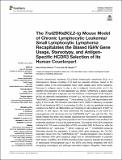Por favor, use este identificador para citar o enlazar a este item:
http://hdl.handle.net/10261/265585COMPARTIR / EXPORTAR:
 SHARE SHARE
 CORE
BASE CORE
BASE
|
|
| Visualizar otros formatos: MARC | Dublin Core | RDF | ORE | MODS | METS | DIDL | DATACITE | |

| Título: | The Traf2DNxBCL2-tg mouse model of chronic lymphocytic leukemia/small lymphocytic lymphoma recapitulates the biased IGHV gene usage, stereotypy, and antigen-specific HCDR3 selection of its human counterpart |
Autor: | Pérez-Chacón, Gema CSIC ORCID; Zapata, Juan M. CSIC ORCID | Palabras clave: | TRAF2 BCL2 Chronic lymphocytic leukemia CLL Small lymphocytic lymphoma IGHV BCR stereotipy |
Fecha de publicación: | abr-2021 | Editor: | Frontiers Media | Citación: | Frontiers in Immunology 12: 627602 (2021) | Resumen: | Chronic lymphocytic leukemia (CLL)/Small lymphocytic lymphoma (SLL) is a heterogeneous disease consisting of at least two separate subtypes, based on the mutation status of the immunoglobulin heavy chain variable gene (IGHV) sequence. Exposure to antigens seems to play a role in malignant transformation and in the selection and expansion of more aggressive CLL clones. Furthermore, a biased usage of particular IGHV gene subgroups and the existence of stereotyped B-cell receptors (BCRs) are distinctive characteristics of human CLL. We have previously described that Traf2DN/BCL2 double-transgenic (tg, +/+) mice develop CLL/SLL with high incidence with aging. In this model, TNF-Receptor Associated Factor (TRAF)-2 deficiency cooperates with B cell lymphoma (BCL)-2 in promoting CLL/SLL in mice by specifically enforcing marginal zone (MZ) B cell differentiation and rendering B cells independent of BAFF for survival. In this report, we have performed the sequencing of the IGHV-D-J rearrangements of B cell clones from the Traf2DN/BCL2-tg+/+ mice with CLL/SLL. The results indicate that these mice develop oligoclonal and monoclonal B cell expansions. Allotransplantation of the oligoclonal populations into immunodeficient mice resulted in the preferential expansion of one of the parental clones. The analysis of the IGHV sequences indicated that 15% were mutated (M) and 85% unmutated (UM). Furthermore, while the Traf2DN/BCL2-tg-/- (wild-type), -/+ (BCL2 single-tg) and +/- (Traf2DNDN single-tg) littermates showed the expression of various IGHV gene subgroups, the CLL/SLL expanded clones from the Traf2DN/BCL2-tg+/+ (double-transgenic) mice showed a more restricted IGHV gene subgroup usage and an overrepresentation of particular IGHV genes. In addition, the HCDR3-encoded protein sequence indicates the existence of stereotyped immunoglobulin (Ig) in the BCRs and strong similarities with BCR recognizing autoantigens and pathogen-associated antigens. Altogether, these results highlight the remarkable similarities between the CLL/SLL developed by the Traf2DN/BCL2-tg+/+ mice and its human counterpart. | Descripción: | © 2021 Perez-Chacon and Zapata. | Versión del editor: | http://dx.doi.org/10.3389/fimmu.2021.627602 | URI: | http://hdl.handle.net/10261/265585 | DOI: | 10.3389/fimmu.2021.627602 | E-ISSN: | 1664-3224 |
| Aparece en las colecciones: | (IIBM) Artículos |
Ficheros en este ítem:
| Fichero | Descripción | Tamaño | Formato | |
|---|---|---|---|---|
| The_Traf2DNxBCL2-tg_Pérez_Chacón_PV_Art2021.pdf | 2,92 MB | Adobe PDF |  Visualizar/Abrir |
CORE Recommender
PubMed Central
Citations
1
checked on 17-abr-2024
SCOPUSTM
Citations
2
checked on 23-abr-2024
WEB OF SCIENCETM
Citations
2
checked on 26-feb-2024
Page view(s)
37
checked on 26-abr-2024
Download(s)
74
checked on 26-abr-2024

